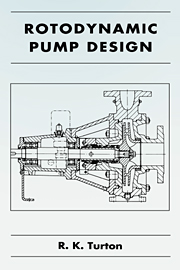Book contents
- Frontmatter
- Contents
- Preface
- Symbols
- 1 Fundamental principles
- 2 Cavitation in pumps
- 3 Centrifugal pump principles
- 4 Principles of axial and mixed flow pumps
- 5 Flow calculations in pumps and an introduction to computer aided techniques
- 6 Single stage centrifugal pump design
- 7 The design of axial and mixed flow pumps
- 8 Basic design principles of shafts, bearings and seals, and selection of drive
- 9 Pump design for difficult applications
- 10 An introduction to the next stage in the pump design process
- References
- Index
3 - Centrifugal pump principles
Published online by Cambridge University Press: 29 September 2009
- Frontmatter
- Contents
- Preface
- Symbols
- 1 Fundamental principles
- 2 Cavitation in pumps
- 3 Centrifugal pump principles
- 4 Principles of axial and mixed flow pumps
- 5 Flow calculations in pumps and an introduction to computer aided techniques
- 6 Single stage centrifugal pump design
- 7 The design of axial and mixed flow pumps
- 8 Basic design principles of shafts, bearings and seals, and selection of drive
- 9 Pump design for difficult applications
- 10 An introduction to the next stage in the pump design process
- References
- Index
Summary
Introduction
When designing a pump a number of design variables need to be determined:
impeller rotational speed
impeller inlet or suction dimensions
impeller outlet diameter
impeller blade number
impeller blade passage geometry, including inlet and outlet blade angles
impeller position relative to the casing
collector leading dimensions (volute throat area or diffuser geometry)
pump construction and materials.
There are a number of approaches to design, chief among which are: small changes from existing designs to give a slight change in head or flow range; design using empirical information, tabular and graphical; and computer based approaches which are in some instances based on empirical data and more recently use finite element or finite difference approaches. The use of these techniques will be discussed later. The sections which now follow survey some of the empirical information available. Typical pump cross-sections of single-stage end suction, and double suction designs and of a multi-stage machine are shown in Figures 3.1, 3.2 and 3.3.
Choice of rotational speed
As will be clear from a reading of the later chapters on design, the choice of rotational speed is interlocked with other parameters, but there are empirical speed limits as given, for example, by the American Hydraulic Institute Standards (1983) reproduced in many handbooks. Clearly the rotational speed is limited to a range of synchronous speeds when using electric motor on a 50 or 60 HZ supply frequency. For large pumps, turbine or diesel drive is used, and the eventual rotational speed is a compromise between hydraulic design and driver considerations.
- Type
- Chapter
- Information
- Rotodynamic Pump Design , pp. 29 - 59Publisher: Cambridge University PressPrint publication year: 1994



